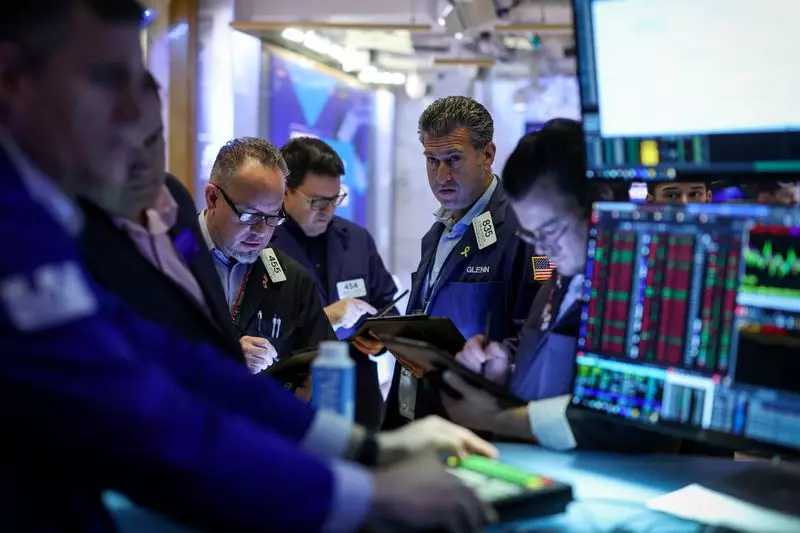The financial landscape in the United States is grappling with unease as Wall Street’s main indexes appear poised for a decline at the market’s opening. This apprehension primarily stems from rising fears regarding elevated interest rates anticipated for the coming year. Despite this uncertainty, a surprisingly mild inflation report has somewhat mitigated the prospective losses, suggesting a complex interplay between economic indicators and market expectations.
The heart of the matter revolves around the Personal Consumption Expenditure (PCE) index, the Federal Reserve’s favored measure of inflation. Recent data from the Commerce Department revealed that the PCE index rose 2.4% year-on-year in November, slightly below the anticipated 2.5%. This deviation from expectations seems to have shifted investor sentiment, leading traders to adjust their forecasts regarding interest rate cuts. Now, market participants are speculating a potential rate reduction as early as March 2025, with another cut expected by October, following a February that previously held a 50% chance for action.
The sentiment on Wall Street has been distinctly jolted this week after the Federal Reserve painted a cautious picture on economic recovery. While the central bank projected only a pair of rate reductions in 2025, it simultaneously raised its inflation forecasts, signaling an ongoing commitment to monitoring inflationary pressures. This development has prompted analysts and investors alike to reassess their positions in light of a resilient economy that continues to grapple with high inflation rates.
Mike Dickson, head of research at Horizon Investments, aptly noted that before the Fed’s last meeting, inflation concerns were somewhat subdued. However, the Fed’s insistence that the battle against inflation is far from over has rekindled worries about the balance between maintaining a robust labor market and managing inflationary threats. This delicate equilibrium is crucial as the economy navigates the uncertain waters of potential policy adjustments in the months ahead.
In addition to fiscal policies directly related to the Fed, political maneuvering in Washington remains a critical factor. The U.S. Congress is engaged in urgent negotiations to prevent a partial government shutdown, a scenario that could exacerbate market volatility. This political discord is significant, particularly as more than three dozen Republicans have dismissed incoming President Donald Trump’s proposal to leverage this crisis to raise the national debt ceiling. Observers are skeptical about the likelihood of a timely resolution and expect a new spate of spending measures around year-end instead.
Market performance has been notably bearish, with the Nasdaq poised to experience its first decline in five weeks. The S&P 500 is on track for its most challenging week since September, while the Dow Jones Industrial Average is facing its steepest weekly decline since March 2023. Analysts at various Wall Street firms still project an optimistic outlook for the stock market next year, with S&P 500 targets stretching between 6,000 and 7,000 points. Currently, the index resides near the 5,900 mark, indicating a fragile state of investor confidence.
Among the individual players in the market, tech giants such as Tesla, Nvidia, and Amazon.com have all seen downturns of approximately 1% in premarket trading. Meanwhile, Nike has encountered a steep drop of 5% after issuing disappointing revenue forecasts for the upcoming third quarter. This announcement underscores the volatility and challenges facing even the most established brands in an unpredictable market environment.
In contrast, FedEx has bucked the downward trend, witnessing an impressive 8.2% surge following its announcement about restructuring operations through the anticipated spinoff of its freight trucking division. Such strategic moves reflect a broader trend among corporates seeking to consolidate their core operations amidst economic uncertainty.
Eli Lilly also experienced gains, rising 6.4% after its competitor Novo Nordisk reported underwhelming results from a late-stage trial of its obesity drug. This event underscores the intense competition within the pharmaceutical sector and the resonating effects of trial outcomes on stock valuations.
As Wall Street navigates a landscape shaped by multifaceted challenges, from inflationary pressures to political strife and corporate dynamics, the outlook appears increasingly uncertain. Investors will need to remain vigilant and adaptive, keeping an eye on the evolving economic indicators and policy directions that lie ahead. The balance between sustaining economic growth and controlling inflation will be pivotal in determining the market’s trajectory in the coming months. In these times of volatility, a keen analysis of both macroeconomic factors and individual company performance will be essential for navigating the stock market landscape.

